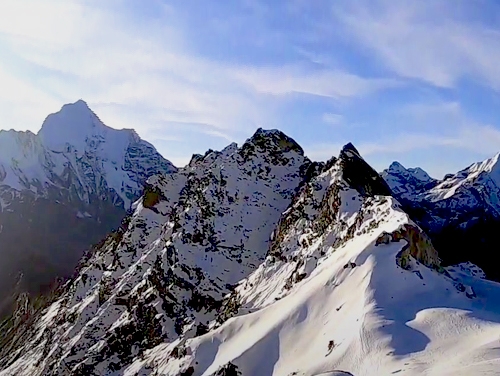Summary of Naya Kang Peak Climbing
Naya Kanga peak is renowned as Ganga La Chuli peak. This mountain, which is part of the wider Langtang region, is one of Himalayan Nepal's most popular climbs. Nayakanga Summit, which rises to a magnificent height of 5,844m to the south of Kyanjin Gompa, is a magnificent-looking peak.
Rhododendron, fir, blue pine, and birch make up the subtropical woods of the lower valley, where endangered red pandas, rhesus and langur monkeys, musk deer, Himalayan black bears, and leopards live. The trees become shorter and the valley opens up for breathtaking views as the altitude rises. The trail leading to the old Buddhist monastery at Kyanjing Gompa, 3970 meters, is lined by chortens.
Climbing Naya Kanga peak provides breathtaking views of the peaks Langtang Lirung 7246m, Ganesh Himal 6704m, Shishapangma 8013m, Langsisa Ri 6774m, Pemthang Ri 6,836m, Pemthang Kapro Ri (6,830m), and Langtang II 6,571m, Yala Peak (5500 m), Paldor Peak (5896 m). You can also see Langtang Valley, Tibetan monasteries, breathtaking scenery, and Rasuwa Tamang culture.
How to Reach Naya Kang Peak?
The Naya Kanga Peak Trekking trek begins in Syabrubesi after a 6- to 7-hour journey from Kathmandu. TheLangtang valley is traversed by the path. The stunning Bambo Valley, Lama Hotel, Langtang Valley, Kyanjin Gompa, Tseku Ri, and Ganaja La Chuli Base Camp are among the sights you'll see.
The 4950m high camp is where the summit attempt begins. Below the summit ridge, the snow and ice slopes can be 50 degrees steep. You will finally reach the top of Naya Kanga peak after the last ascent. Naya Kanga is often reached by ascending the northeast ridge across an ice and snow line. For the ascent of Naya Kanga, we take the Langtang trek route to Kyangjin (3,749m). There are a number of hills to the north of Kangjin that offer both.
How Difficult is Naya Kang Peak Climbing?
It is one of the more technically difficult summits to climb in the Langtang region. Despite this, there have been numerous successful ascents of the peak, therefore it is not impossible to reach the summit. You will successfully summit Naya Kang Peak if all necessary conditions, such as those relating to your physical well-being and your level of preparation, are met.
Naya Kang Peak climbing Accommodation
Unless you choose to sleep in a tent, accommodation at Naya Kang Peak Climbing may be in good inns run by surrounding residents. Each hotel has a main public space with a fireplace, while the bedrooms are unheated and come with beds and mattresses, as well as a blanket and pillows. You are required to bring your own sleeping bag. The showers are normally powered by gas, and while some still employ the distinctive 'drop' toilets, the majority now have flush systems.
We use a four-season sleeping bag in addition to a high-quality sleeping mat. Lower down, you may need to use a sleeping bag liner to sleep in an open zipped four-season bag to avoid overheating. The porters will transport your essential stuff up to a weight of 15 kg and can meet the needs of the entire group. You'll even have your guide and mountaineering sherpa with you the entire time to ensure your safety and satisfaction.
Emergency evacuation while doing Naya Kang Peak Climbing
In Nepal, helicopter evacuations are the maximum usual method of managing an emergency, and there may be a well-set-up infrastructure for managing logistics. Incidents are uncommon, and Naya Kang Peak is positioned in a well-supported area of Nepal.
It is virtually crucial to have travel insurance in the area and to be clear about your vacation spot and what you're doing to the insurance company. On the occasion of an emergency, the team, in addition to the guide, porters, and everybody else around might be accountable for moving a casualty.
But the best advice withinside the case of altitude sickness is to keep away from risk and descend. Further elevation can quickly result in far more serious cerebral or pulmonary edema, consequently, it is usually nice to descend if you're feeling truly unwell.
Best season for Naya Kang Peak Climbing
Have you ever attempted an above 5500-meter-high mountain climb? If you have, you must be aware of how lovely climbing is. Even if you haven't, you should make a plan to climb Naya Kang Peak, one of the most spectacular climbing summits, at least once in your life.
The weather is pleasant; it is not too freezing or too hot, and there is less rain. The busiest months are March to May and October to November. Because they are ideal for hiking in terms of weather, and trails become busy during this time.
Spring is mostly stable and dry, with a mild climate. Every day, the Annapurna region gives a crystal clear picture of the mountains and scenery during the Spring season. During the day, temperatures might reach 15 to 20 degrees Celsius. At night, the temperature might dip to - 8 to 10 degrees Celsius. The presence of thousands of flowers and vegetation in the spring makes the climbing more beautiful and delightful.
Autumn is another fantastic time to hike Naya Kang Peak. Temperatures in the autumn range from 12 to 20 degrees Celsius during the day and -5 to 9 degrees Celsius at night. During the ascent, there is a low possibility of rain and snowfall.

